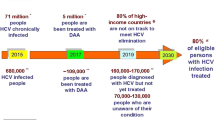Abstract
Background
Predominant modes of hepatitis C virus (HCV) transmission vary between countries and over time.
Aims
To compare HCV transmission modes in the USA and northern China.
Methods
We conducted a prospective study enrolling two cohorts of chronic HCV patients in the USA, and in China at Beijing, and at Gu’an and Kuancheng counties in Hebei. Patients self-reported the most likely source and year of infection.
Results
A total of 1957 patients were studied (1000 USA; 957 China—428 Beijing, 387 Gu’an, 142 Kuancheng). The predominant infection sources were transfusion (23.0%) and injection drug use (IDU) (32.1%) in the USA and transfusion (64.5%) in northern China. Within China, transfusion was the most common source in Beijing (62.1%) and Gu’an (88.1%), and medical procedures (35.9%) and IDU (12.0%) in Kuancheng. Infection via transfusion decreased significantly in the USA (35.1–4.6%) and Beijing (84.2–14.3%) but remained frequent in Gu’an (90.5–72.5%) over time. Infection via IDU decreased from 32.4% in those ≥61 years to 25.0% in those 41–50 years but increased to 46.5% in those ≤40 years in US patients and decreased over time from 38.7 to 1.9% in Kuancheng. Infection via medical procedures increased over time in Beijing (7.0–33.3%) and remained frequent in Kuancheng (45.2–31.1%).
Conclusions
There are major differences in presumed HCV infection source between the USA and northern China. Favorable as well as worrisome changes in the modes of HCV transmission in both countries were observed.




Similar content being viewed by others
References
World Health Organization. Hepatitis C 2016 (cited 2016). Available from: http://www.who.int/mediacentre/factsheets/fs164/en/.
Ditah I, Ditah F, Devaki P, et al. The changing epidemiology of hepatitis C virus infection in the United States: National Health and Nutrition Examination Survey 2001 through 2010. J Hepatol. 2014;60:691–698.
Afdhal N, Zeuzem S, Kwo P, et al. Ledipasvir and sofosbuvir for untreated HCV genotype 1 infection. N Engl J Med. 2014;370:1889–1898.
Chayama K, Takahashi S, Toyota J, et al. Dual therapy with the nonstructural protein 5A inhibitor, daclatasvir, and the nonstructural protein 3 protease inhibitor, asunaprevir, in hepatitis C virus genotype 1b-infected null responders. Hepatology. 2012;55:742–748.
Feld JJ, Jacobson IM, Hezode C, et al. Sofosbuvir and velpatasvir for HCV genotype 1, 2, 4, 5, and 6 infection. N Engl J Med. 2015;373:2599–2607.
Ferenci P, Bernstein D, Lalezari J, et al. ABT-450/r-ombitasvir and dasabuvir with or without ribavirin for HCV. N Engl J Med. 2014;370:1983–1992.
Gane EJ, Stedman CA, Hyland RH, et al. Nucleotide polymerase inhibitor sofosbuvir plus ribavirin for hepatitis C. N Engl J Med. 2013;368:34–44.
Poordad F, McCone J Jr, Bacon BR, et al. Boceprevir for untreated chronic HCV genotype 1 infection. N Engl J Med. 2011;364:1195–1206.
Zeuzem S, Andreone P, Pol S, et al. Telaprevir for retreatment of HCV infection. N Engl J Med. 2011;364:2417–2428.
Smith BD, Morgan RL, Beckett GA, et al. Recommendations for the identification of chronic hepatitis C virus infection among persons born during 1945–1965. MMWR Recomm Rep. 2012;61:1–32.
Moyer VA. Screening for hepatitis C virus infection in adults: U.S. Preventive Services Task Force recommendation statement. Ann Intern Med. 2013;159:349–357.
Centers for Disease Control and Prevention. Viral Hepatitis- Hepatitis C Information 2016 (cited 2016). Available from: http://www.cdc.gov/hepatitis/HCV/HCVfaq.htm.
Sievert W, Altraif I, Razavi HA, et al. A systematic review of hepatitis C virus epidemiology in Asia, Australia and Egypt. Liver Int. 2011;31:61–80.
Rao HY, Sun DG, Yang RF, et al. Outcome of hepatitis C virus infection in Chinese paid plasma donors: a 12–19-year cohort study. J Gastroenterol Hepatol. 2012;27:526–532.
Xu CJ, Zhang CP, Luo BF, et al. Prevalence and characterization of hepatitis B and C virus infections in a needle-sharing population in Northern China. BMC Public Health. 2015;15:460.
Bruix J, Sherman M. American Association for the Study of Liver D. Management of hepatocellular carcinoma: an update. Hepatology. 2011;53:1020–1022.
Rao H, Wei L, Lopez-Talavera JC, et al. Distribution and clinical correlates of viral and host genotypes in Chinese patients with chronic hepatitis C virus infection. J Gastroenterol Hepatol. 2014;29:545–553.
Shan H, Wang JX, Ren FR, et al. Blood banking in China. Lancet. 2002;360:1770–1775.
Chinese News Agency. Blood donation law. Health, September 22, 1998.
Hauri AM, Armstrong GL, Hutin YJ. The global burden of disease attributable to contaminated injections given in health care settings. Int J STD AIDS. 2004;15:7–16.
Shepard CW, Finelli L, Alter MJ. Global epidemiology of hepatitis C virus infection. Lancet Infect Dis. 2005;5:558–567.
Alter MJ. Epidemiology of hepatitis C. Hepatology. 1997;26:62S–65S.
Alter MJ. Hepatitis C virus infection in the United States. J Hepatol. 1999;31:88–91.
Williams IT, Bell BP, Kuhnert W, Alter MJ. Incidence and transmission patterns of acute hepatitis C in the United States, 1982–2006. Arch Intern Med. 2011;171:242–248.
Wong HK, Lee CK, Leung JN, Tsoi WC, Lin CK. Risk factor analysis of hepatitis C virus infection among Chinese blood donors in Hong Kong. Transfus Med. 2012;22:133–136.
Acknowledgments
The study was funded by the University of Michigan Health System and Peking University Health Science Center Joint Institute for Translational and Clinical Research, and Bristol-Myers Squibb.
Author information
Authors and Affiliations
Corresponding author
Ethics declarations
Conflict of interest
ASL has received research grants from Bristol-Myers Squibb and Gilead. LW has received research grants from Roche and Bristol-Myers Squibb and has served as an advisor for Gilead and Abbott. RJF has received research grants from Bristol-Myers Squibb, Gilead and Janssen. Other authors have no conflicts of interest to declare.
Rights and permissions
About this article
Cite this article
Wu, E., Yang, M., Rao, H. et al. Temporal Changes in the Modes of Hepatitis C Virus Transmission in the USA and Northern China. Dig Dis Sci 62, 2141–2149 (2017). https://doi.org/10.1007/s10620-017-4619-6
Received:
Accepted:
Published:
Issue Date:
DOI: https://doi.org/10.1007/s10620-017-4619-6




